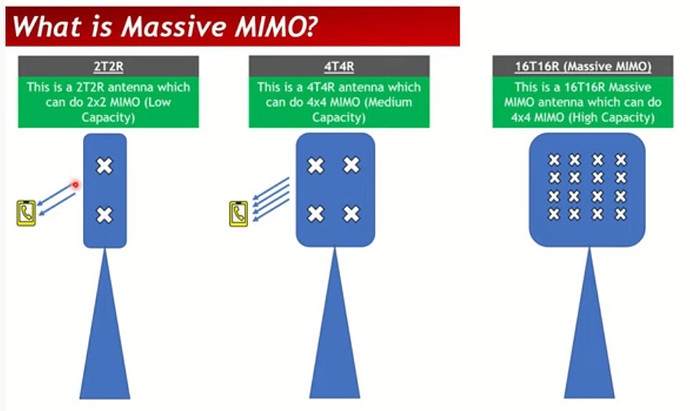5G Massive MIMO is one of the most sought after topic and it is also one of the most complex and confusing topic as well.
However, in this 30 minute session, Massive MIMO is demystified and anyone who goes through this session should be able to understand this topic clearly!
In this session, we have tried to simplify Massive MIMO by breaking it down into various parts.
It explains the definition of Massive MIMO along with its applications.
All the related topics like Beam-Forming, CSI Feedback, PMI and Multi-User MIMO are comprehensively covered.
Reference: 3GPP 38214
Youtube: 5G Massive MIMO Made Simple : Learn All About Massive MIMO & Beam-Forming In 30 minutes! - YouTube
5 Likes
If we are using 16T16R how may beam will be maximum ? No of beams depends on Massive MIMO configuration ?
Massive MIMO Advanced Antenna technology in 5G:
Massive MIMO is an advanced antenna technology used in 5G networks to significantly boost network capacity, coverage, and data rates.
-
Massive MIMO 
 : Massive MIMO (Multiple Input Multiple Output) is an extension of MIMO technology, where a large number of antennas are used at the base station (gNodeB) to transmit and receive data from multiple user devices simultaneously
: Massive MIMO (Multiple Input Multiple Output) is an extension of MIMO technology, where a large number of antennas are used at the base station (gNodeB) to transmit and receive data from multiple user devices simultaneously 
 .
.
-
More antennas 

 : In Massive MIMO, the base station uses a large number of antennas (e.g., 64, 128, or even more) to create multiple data streams, which enables better connectivity and higher data rates for users
: In Massive MIMO, the base station uses a large number of antennas (e.g., 64, 128, or even more) to create multiple data streams, which enables better connectivity and higher data rates for users  .
.
-
Beamforming  : Beamforming in Massive MIMO focuses the signal energy towards specific user devices, increasing signal strength and reducing interference from other users or devices. This results in better connection quality and faster data rates
: Beamforming in Massive MIMO focuses the signal energy towards specific user devices, increasing signal strength and reducing interference from other users or devices. This results in better connection quality and faster data rates  .
.
-
Spatial multiplexing  : Massive MIMO uses spatial multiplexing to transmit multiple data streams simultaneously, over the same frequency band. This increases the network capacity, allowing it to serve more users at the same time without congestion
: Massive MIMO uses spatial multiplexing to transmit multiple data streams simultaneously, over the same frequency band. This increases the network capacity, allowing it to serve more users at the same time without congestion  .
.
-
Enhanced coverage  : With Massive MIMO, the coverage area of the network is improved due to the ability of the antennas to focus signal energy in specific directions. This allows for better signal quality even at the edges of the cell, providing a more consistent user experience
: With Massive MIMO, the coverage area of the network is improved due to the ability of the antennas to focus signal energy in specific directions. This allows for better signal quality even at the edges of the cell, providing a more consistent user experience  .
.
Real Life Examples :
In summary, Massive MIMO is a key antenna technology in 5G networks that utilizes a large number of antennas to improve capacity, coverage, and data rates. Beamforming and spatial multiplexing are essential techniques in Massive MIMO, enabling better connectivity and a superior user experience 
 .
.
LinkedIn: 
